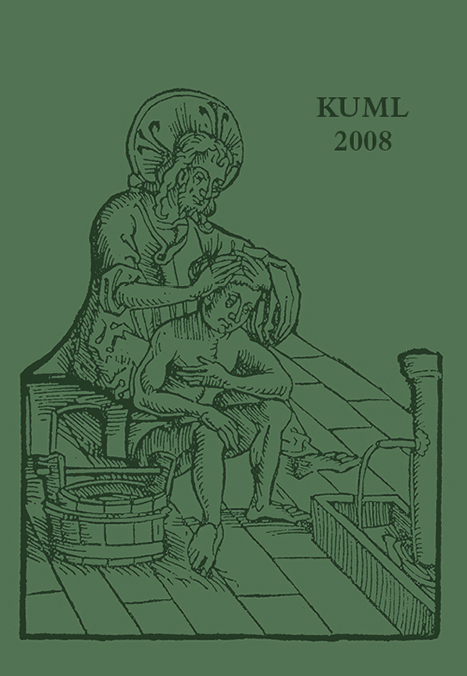Badstuer i middelalderen
DOI:
https://doi.org/10.7146/kuml.v57i57.24661Nøgleord:
badstuer, middelalderResumé
Bath-houses in medieval Denmark – a cultural history
The subject of this article is bath-houses in medieval Denmark. The text is based on all available written sources from Denmark, but in order to obtain a fuller perspective on some aspects of the history of bath-houses it has also been necessary to use German sources as a supplement.
Based on the scant historical records dealing with the course of actual bathing activity, it is argued that the most common bath was the sweat bath (similar to a modern sauna) rather than tub baths. A stove covered with granite boulders was heated and the bathers would produce sweat using either the direct heat of the stove or from steam produced by pouring cold water onto the hot stones. Sweating was further stimulated by beating the body with bundles of birch twigs and the bath culminated with rinsing in cold water (figs. 2-4). It is argued that, similar to the situation in both Germany and Sweden, bath-house staff would offer haircuts, bleeding and the treatment of wounds in addition to an actual bath (figs. 5-6). Referring to specific medieval illustrations, some argue that men and women bathed together in the public bath-houses, leading to sexual excesses. However, the relevant illustrations often depict brothels and not public baths (fig. 1).
It is evident from historical records that members of all social classes frequented the public bath-houses – even royalty. From the early 14th century onwards we have historical evidence of so-called soul baths i.e. sums of money bequeathed by wealthy people to the poor to enable the latter to take a bath, often accompanied by a meal. Such bequests were common in the late 15th century but disappeared abruptly with the Reformation. According to medieval records, the use of bath-houses was also considered important in order to maintain health.
The earliest indications in historical records of the existence of bath-houses in Denmark are found in Saxo’s Chronicles from the end of 12th century. From the 1260s onward specific bath-houses in towns appear in the historical records. Judging from the number of bath-houses mentioned in Danish towns it is argued that public bath-houses were a common feature in the urban landscape of medieval Denmark.
The number of public bath-houses in towns declined at the beginning of the 16th century and even though a few existed in the major cities up until the 18th century the popularity of these institutions declined. The reasons for this are epidemics of syphilis occurring from the 1490s onward, the phasing out of soul baths and possibly a change in attitudes towards nudity and personal hygiene that resulted in a decline in general cleanliness in post-medieval times.
Mikael Manøe Bjerregaard
Vejle Museum
Downloads
Publiceret
Citation/Eksport
Nummer
Sektion
Licens
Fra og med årgang 2022 er artikler udgivet i Kuml med en licens fra Creative Commons (CC BY-NC-SA 4.0).
Alle tidligere årgange af tidsskriftet er ikke udgivet med en licens fra Creative Commons.


